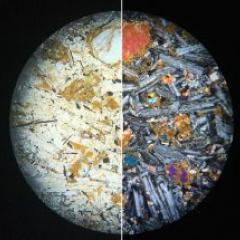Process optimisation can be elusive. Complex processes, noisy data, and a general need to avoid unwarranted risk can overwhelm metallurgists and bog down improvement initiatives with uncertainty about where to even begin. However, a back-to-basics approach that is often overlooked is understanding ore mineralogy, and the power this has in guiding process improvement efforts.
Mineralogy is a big driver for many of the strategies underpinning mineral processes. From the target grind size of a comminution circuit and its subsequent throughput, to reagent schemes used in flotation, to the amount of regrinding required to achieve target grades, understanding mineralogy and its implications can help define effective strategies and sensible processing philosophies. Yet how many of these variables are conventionally ‘set-and-forget’, when they should most likely be adapted to the mineralogy of the prevailing feed? Below are some recent examples of process improvement opportunities that we identified after interrogating ore mineralogy.
Improvement of flotation recovery through reduced lime addition
Lime is commonly added to elevate flotation pulp pH to depress non-valuable iron sulphides such as pyrite, although this will also cause some depression of valuable metal sulphides as an unwanted side-effect. In one large copper-gold operation, a very high cleaner circuit pH of around 11.8 was typically targeted. However, analysis of the feed mineralogy indicated very low levels of pyrite, which meant that aggressive lime additions were not necessary. Upon reducing pH levels to 8.5, an improvement in cleaner copper recovery of 1.2% was realised due to improved flotation kinetics, without a decline in concentrate grades. Additional benefits included reduced lime consumption and cost savings, as well as reduced scaling of pipes and tanks in the concentrator.
Increasing throughput by identifying 'forgiving ores'
Maintaining a desired grinding circuit product size is frequently a  major constraint on overall throughput. However, there is often very little knowledge about how flexible this target may be, and whether it is truly applicable to the diverse ore-types that are processed in a concentrator. The graph below shows how galena liberation changed with P80 for two different ores processed in a Pb/Zn flotation circuit (P80 target of 106 mm). Finer product sizings were required to achieve adequate levels of liberation for Sample 1. The other sample (Sample 2) however, was very ‘forgiving’, and finer grinds were did not yield significant liberation benefits. For this ore type, processing strategies were changed to allow the grind P80 to drift to coarser ranges, in order to facilitate ~5% throughput increases without significant declines in downstream flotation recovery.
major constraint on overall throughput. However, there is often very little knowledge about how flexible this target may be, and whether it is truly applicable to the diverse ore-types that are processed in a concentrator. The graph below shows how galena liberation changed with P80 for two different ores processed in a Pb/Zn flotation circuit (P80 target of 106 mm). Finer product sizings were required to achieve adequate levels of liberation for Sample 1. The other sample (Sample 2) however, was very ‘forgiving’, and finer grinds were did not yield significant liberation benefits. For this ore type, processing strategies were changed to allow the grind P80 to drift to coarser ranges, in order to facilitate ~5% throughput increases without significant declines in downstream flotation recovery.
Root-cause disgnosis of poor cleaner performance
At a nickel-copper flotation concentrator, the metal-upgrade across the cleaner flotation circuit was poor. Preliminary improvement efforts were focussed around the reagent scheme and pulp densities in the cleaner cells, to no avail. It was not until the mineralogy of the rougher circuit concentrates was interrogated, that the root-cause of the problem was identified. While the first two rougher concentrates were of sufficient liberation for good cleaning performance, the scavenger concentrates were not. Compared to the rougher concentrate, the scavenger concentrate had more complex intergrowths between chalcopyrite and non-sulphide gangue, and between pentlandite and pyrrhotite. A regrind P80 of between 15-20 mm was identified as appropriate for the scavenger concentrate, which was targeted in the next phase of testing.

Conclusions
Improvement efforts defined by a trial-and-error approach often lead to wasted time, resources and opportunity. Understanding ore mineralogy is key to circumventing this, and to eventually guide rational, prescriptive strategies that improve processing performance. As illustrated in these case studies, benefits of improved mineralogical understanding can range from ‘quick wins’ to the identification of key constraints that prevent process objectives from being met. Furthermore, it can also provide key justification for major circuit changes that may be necessary to achieve these objectives. Mineralogical analysis should be an integral part of every future ore characterisation programme, and should also be the first step in the never-ending search for processing improvement opportunities.
Contact us for more information on our mineralogy and process optimisation services.



